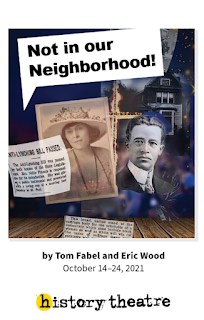William T. Francis was a lawyer and US ambassador to Liberia, where he contracted yellow fever and died. This isn't a spoiler; the play begins with his funeral, and then jumps back about five years to show the events leading up to his appointment. His wife Nellie was a suffragist and co-authored Minnesota's anti-lynching bill with her husband, in response to the lynching of three Black men in Duluth in 1920. The two were prominent in society, and the play shows them happily living their life, until Nellie decides that Black people shouldn't be relegated to one neighborhood (that would be all but destroyed by the construction of I94 about 30 years later, BTW), and should be free to live where they pleased. They didn't think anyone would have a problem with that here in the North, but of course that's not true; racism exists everywhere, it's just sometimes less blatant. The play details how the neighborhood "improvement society" first tried to buy them out, then marched in front of their home and set a cross on fire in their yard. Law enforcement seemed more interested in keeping the peace and avoiding a riot rather than justice, but Nellie and Bill didn't back down.
 |
| Darius Dotch and Erin Nicole Farsté (photo by Rick Spaulding) |
The design of the show is impressive, including Anna Hill's rich and smart period clothing. Rick Polenek's set may look like just a simple silhouette of houses, with a blueprint on the floor, but it actually serves as a clever backdrop for projections that transform it from one house to another, as well as other St. Paul locations like the Landmark Center. Between scenes, images of period advertisements featuring all white faces are projected next to historical photos of the Black community of the era, while period music plays. Trigger warning: during one somber scene transition we see graphic images of lynchings and other violence against Black people, effective in conveying the gravity of the situation the Francises found themselves in, but difficult to watch. (Video design by Kathy Maxwell, lighting design by Wu Chen Khoo, sound design by C. Andrew Mayer.)
Perhaps one of the things we learned in the last year and a half is that it's vital that we understand our history, in order to make a better and more just world for everyone. No theater helps us understand our local history better than History Theatre. Not in Our Neighborhood continues through next weekend only, and is also available to watch virtually. Click here for details and tickets.

